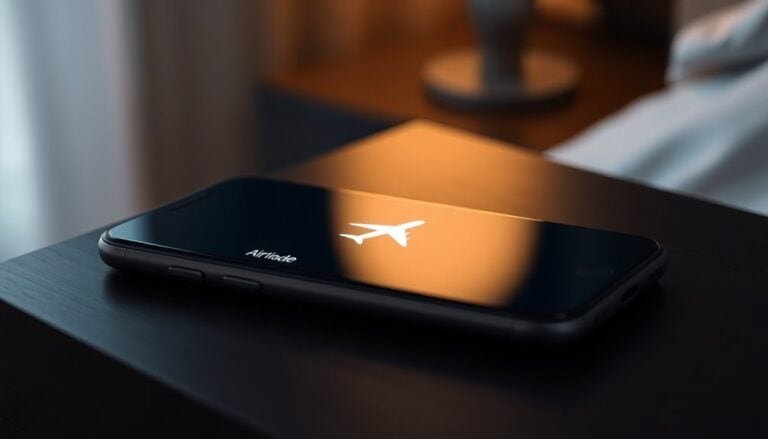Smartphone Radiation: Safe Carrying Practices

To minimize smartphone radiation exposure, keep the device away from your body by avoiding pockets or bras, and use airplane mode when not in use. Limit calls in moving vehicles and establish phone-free zones at home, particularly in bedrooms.
For safer calls, use headsets or speakerphones to reduce direct contact; wired headsets emit less radiation, while airtube models transmit audio without it. Explore additional practices that can further enhance safety with smartphone usage.
Disclaimer: As an affiliate, I may collect a share of sales from the links on this page.
Understanding RF Radiation

Radiofrequency (RF) radiation, a type of low-energy, non-ionizing radiation, is essential in modern communication technology.
You encounter RF radiation from devices like cell phones, radios, and televisions. Cell phones typically operate within the frequency range of 0.7–2.7 GHz for 2G, 3G, and 4G networks, while 5G technology plans to utilize frequencies up to 80 GHz. The charging process of cell phones does not emit harmful radiation, but it does produce a tiny amount of low-frequency RF energy during charging.
Essential for transmitting signals, RF radiation is emitted through antennas within your mobile phones. Significantly, RF radiation is classified as non-ionizing, which means it doesn’t have enough energy to break chemical bonds, therefore posing different exposure characteristics compared to ionizing radiation like X-rays. Recent research indicates that high exposure to RF radiation has been linked to heart tumors in male rats, indicating the need for caution in long-term exposure to these frequencies.
Current Safety Assessments
When evaluating smartphone safety, several key factors come into play.
First, Specific Absorption Rate (SAR) measures how much radiofrequency energy your body absorbs while using a phone. Devices like the ZTE Blade V10 exhibit some of the lowest SAR levels. SAR ratings are crucial for understanding the potential EMF radiation exposure from smartphones. Additionally, international standards mandate that smartphones must comply with radiation emission limits to ensure user safety.
Additionally, different smartphone models and network providers can impact radiation levels considerably. To minimize exposure, you can limit usage, and utilize speaker mode or headsets.
Regulatory guidelines from the FCC and WHO guarantee smartphones emit RF radiation within safe SAR limits, typically below 1.6 W/kg.
Recent WHO studies show no strong evidence linking mobile phone radiation to considerable health risks.
The Debate on Cancer Risks

The ongoing debate regarding cellphone cancer risks primarily stems from the nature of radiofrequency radiation as a low-energy form.
Despite the widespread use of cell phones by over 3 billion people, the evidence remains inconclusive. Concerns focus on potential brain tumor risks, especially with prolonged use.
- Over 3 billion people are exposed daily.
- Proximity to your brain raises alarms for some.
- Studies on long-term users show mixed results.
- Regulatory bodies conclude no strong link to cancer. Additionally, WHO classifies radio frequency radiation as a potential carcinogen, highlighting the need for continued research.
While research is ongoing, a clear consensus indicates that current data doesn’t support a definitive cancer risk. Notably, the only recognized biological effect of cell phone radiation is localized heating, which does not significantly raise core body temperature.
Effective Safe Carrying Practices
To reduce radiation exposure from your smartphone, adopting specific carrying practices is vital. Keep your phone away from your body; avoid pockets or bras. Store it in bags or backpacks instead.
Use airplane mode when not in use, and hover in areas with a strong signal to minimize radiation. Limit phone use in moving vehicles; they constantly adjust signal strength.
Establish phone-free zones at home, especially in bedrooms. Consider using radiation-reducing cases that provide an extra layer of safety.
Educate your family about these practices to guarantee everyone limits their exposure effectively and maintains a healthier relationship with technology.
The Role of Headsets and Speakerphones

Headsets and speakerphones play vital roles in minimizing radiation exposure during phone use. Using these alternatives to hold the phone reduces direct contact with your head.
Consider the following options:
- Wired Headsets: They emit less radiation than direct phone contact.
- Airtube Headsets: Designed to transmit audio without radiation to the ear.
- Speakerphone: Keeps the phone away from your body, lowering exposure.
- Bluetooth Headsets: Safer than holding the phone, but still emit some radiation.
While these tools help reduce overall radiation exposure, it’s important to remain informed and exercise caution when using your smartphone.
Texting vs. Calling: Exposure Comparisons
When comparing texting to calling, it’s crucial to examine the differences in radiation exposure.
Texting emits less RF radiation since it requires less power than continuous voice transmission during calls. Consequently, calling increases power consumption and radiation output.
Utilizing your phone in weak signal areas raises radiation emission for both texting and calling, but texting remains the safer choice.
Additionally, keeping the phone at a distance markedly reduces exposure for both activities.
To minimize risks, consider using phones with lower Specific Absorption Rate (SAR) values and prioritize texting over calling whenever possible, particularly in areas with weak signals.
Environmental and Social Considerations
Environmental and social considerations surrounding smartphone use play a pivotal role in understanding their broader impact.
You mightn’t realize that smartphones contribute greatly to our carbon footprint and social dynamics. Consider the following:
- Smartphones account for 63 kilograms of CO2 emissions per device each year.
- The ICT sector could represent 14% of global carbon emissions by 2040.
- Varying regulatory standards for RF radiation impact safety measures across countries.
- Smartphones promote digital inclusion but also lead to cultural dependence on technology.
These points highlight the intertwined relationship between environmental impact and our social behaviors.
Future Research and Technological Innovations
As research into smartphone radiation evolves, the focus is on refining safety standards and technological solutions to mitigate health risks.
Future studies will likely emphasize revised RF exposure limits due to emerging evidence linking RF radiation to health issues. New materials that absorb or shield against RF radiation are being developed, potentially leading to safer phone designs.
Innovations like low-exposure modes and RF-absorbing cases can minimize user exposure. Additionally, public health policies may demand stringent regulations based on thorough epidemiological studies, enhancing our understanding of the long-term impacts of RF radiation on human health and ensuring safer technology usage.
Frequently Asked Questions
Can Airplane Mode Reduce Smartphone Radiation Exposure?
Yes, activating airplane mode can reduce smartphone radiation exposure. It disables wireless functions, stops signal emissions, and minimizes EMF exposure, helping you lower potential health risks while enhancing your focus and personal presence.
How Does Distance From the Body Affect Radiation Levels?
Think of distance as a shield – the farther you keep your phone from your body, the lower the radiation levels. By maintaining space, you considerably reduce exposure and promote better safety for yourself.
Are There Specific Phone Models That Emit Less Radiation?
Yes, specific phone models emit less radiation. For example, the Samsung Galaxy Note 8 and ZTE Blade V10 have low SAR values, making them safer choices if you’re concerned about radiation exposure.
Does Case Material Influence Radiation Exposure?
Yes, case material definitely influences radiation exposure. Conductive cases can divert radiation, while bulkier designs obstruct antennas, raising your phone’s radiation output. Thin, non-conductive cases typically minimize this interference, promoting safer and more efficient phone usage.
Can Children Use Smartphones Safely?
Yes, children can use smartphones safely by limiting screen time, encouraging headphone use, and teaching proper phone handling. Stay involved in their usage to guarantee they benefit without excessive exposure to potential risks.
Conclusion
Understanding smartphone radiation and adopting safe carrying practices is crucial for your health. Using headsets or speakerphones and opting to text can significantly minimize your exposure.
While the risk of radiation is still debated, it’s wise to be proactive in your habits. Staying informed and making protective choices is essential as technology evolves.






